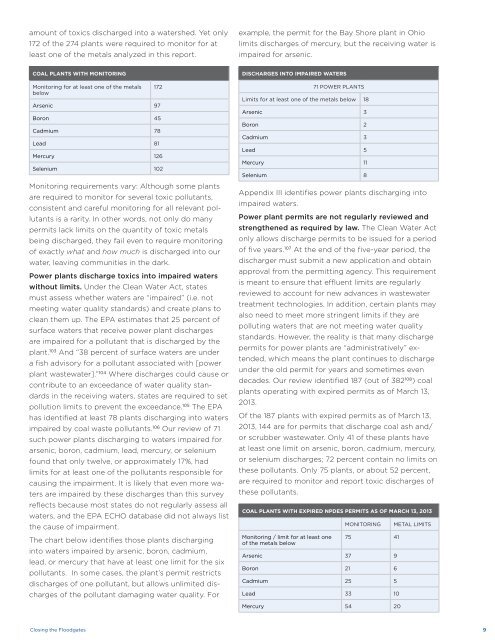CLOSING THE FLOODGATES: - Sierra Club
CLOSING THE FLOODGATES: - Sierra Club
CLOSING THE FLOODGATES: - Sierra Club
Create successful ePaper yourself
Turn your PDF publications into a flip-book with our unique Google optimized e-Paper software.
amount of toxics discharged into a watershed. Yet only172 of the 274 plants were required to monitor for atleast one of the metals analyzed in this report.example, the permit for the Bay Shore plant in Ohiolimits discharges of mercury, but the receiving water isimpaired for arsenic.COAL PLANTS WITH MONITORINGMonitoring for at least one of the metalsbelow172Arsenic 97Boron 45Cadmium 78Lead 81Mercury 126Selenium 102Monitoring requirements vary: Although some plantsare required to monitor for several toxic pollutants,consistent and careful monitoring for all relevant pollutantsis a rarity. In other words, not only do manypermits lack limits on the quantity of toxic metalsbeing discharged, they fail even to require monitoringof exactly what and how much is discharged into ourwater, leaving communities in the dark.Power plants discharge toxics into impaired waterswithout limits. Under the Clean Water Act, statesmust assess whether waters are “impaired” (i.e. notmeeting water quality standards) and create plans toclean them up. The EPA estimates that 25 percent ofsurface waters that receive power plant dischargesare impaired for a pollutant that is discharged by theplant. 103 And “38 percent of surface waters are undera fish advisory for a pollutant associated with [powerplant wastewater].” 104 Where discharges could cause orcontribute to an exceedance of water quality standardsin the receiving waters, states are required to setpollution limits to prevent the exceedance. 105 The EPAhas identified at least 78 plants discharging into watersimpaired by coal waste pollutants. 106 Our review of 71such power plants discharging to waters impaired forarsenic, boron, cadmium, lead, mercury, or seleniumfound that only twelve, or approximately 17%, hadlimits for at least one of the pollutants responsible forcausing the impairment. It is likely that even more watersare impaired by these discharges than this surveyreflects because most states do not regularly assess allwaters, and the EPA ECHO database did not always listthe cause of impairment.The chart below identifies those plants discharginginto waters impaired by arsenic, boron, cadmium,lead, or mercury that have at least one limit for the sixpollutants. In some cases, the plant’s permit restrictsdischarges of one pollutant, but allows unlimited dischargesof the pollutant damaging water quality. ForDISCHARGES INTO IMPAIRED WATERS71 POWER PLANTSLimits for at least one of the metals below 18Arsenic 3Boron 2Cadmium 3Lead 5Mercury 11Selenium 8Appendix III identifies power plants discharging intoimpaired waters.Power plant permits are not regularly reviewed andstrengthened as required by law. The Clean Water Actonly allows discharge permits to be issued for a periodof five years. 107 At the end of the five-year period, thedischarger must submit a new application and obtainapproval from the permitting agency. This requirementis meant to ensure that effluent limits are regularlyreviewed to account for new advances in wastewatertreatment technologies. In addition, certain plants mayalso need to meet more stringent limits if they arepolluting waters that are not meeting water qualitystandards. However, the reality is that many dischargepermits for power plants are “administratively” extended,which means the plant continues to dischargeunder the old permit for years and sometimes evendecades. Our review identified 187 (out of 382 108 ) coalplants operating with expired permits as of March 13,2013.Of the 187 plants with expired permits as of March 13,2013, 144 are for permits that discharge coal ash and/or scrubber wastewater. Only 41 of these plants haveat least one limit on arsenic, boron, cadmium, mercury,or selenium discharges; 72 percent contain no limits onthese pollutants. Only 75 plants, or about 52 percent,are required to monitor and report toxic discharges ofthese pollutants.COAL PLANTS WITH EXPIRED NPDES PERMITS AS OF MARCH 13, 2013Monitoring / limit for at least oneof the metals belowMONITORING75 41Arsenic 37 9Boron 21 6Cadmium 25 5Lead 33 10Mercury 54 20METAL LIMITSClosing the Floodgates9



